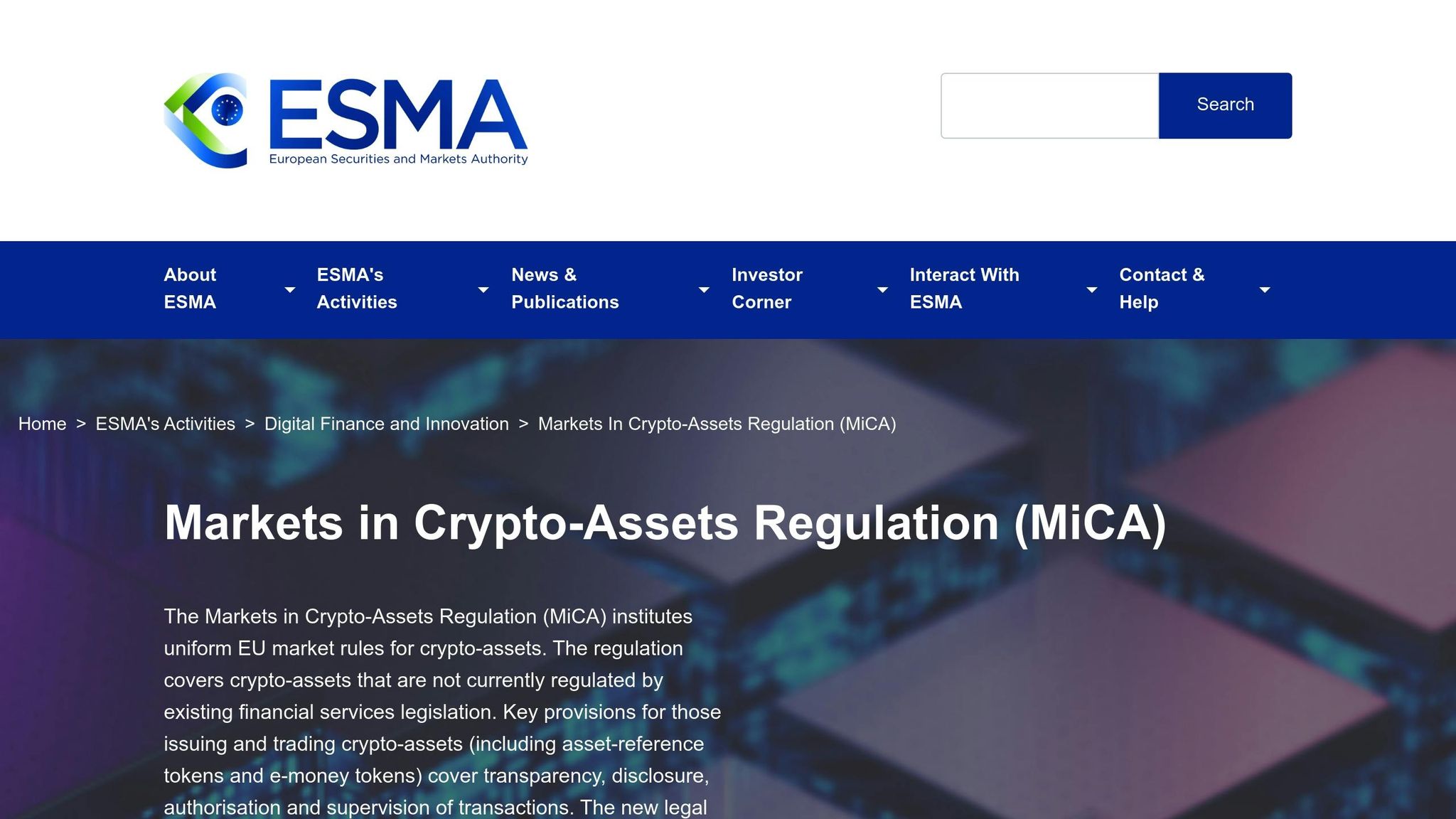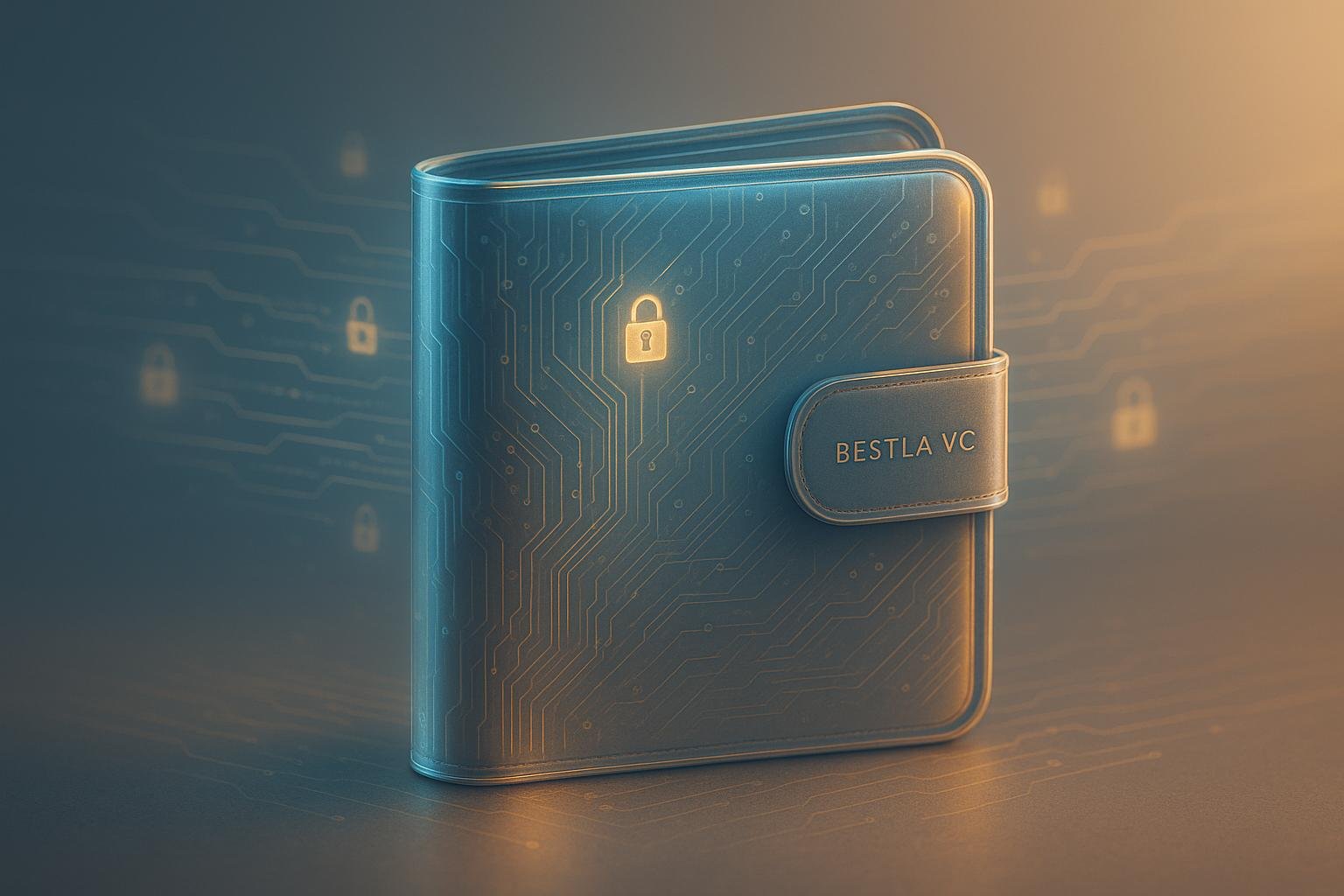The Markets in Crypto-Assets (MiCA) regulation is reshaping wallet encryption by enforcing stricter security rules. Wallet providers must improve encryption, key management, and transaction monitoring to comply by July 2026. Here’s what you need to know:
- Encryption: MiCA mandates AES-256 encryption and encourages quantum-resistant cryptography to future-proof security.
- Key Management: Providers must secure key generation, enforce regular key rotation, and ensure secure deletion with detailed audit logs.
- Transaction Monitoring: Systems must detect suspicious activity, flag high-risk transactions, and maintain detailed records.
- Compliance: Wallets must align with EU cybersecurity frameworks like ENISA and undergo regular security audits.
- MPC (Multi-Party Computation): MiCA promotes splitting private keys across multiple parties to reduce risks.
These measures aim to protect digital assets, improve trust, and set a global standard for wallet security. Providers must act now to upgrade systems and prepare for compliance.
MiCA Regulation Explained: Europe’s New Framework for Cryptocurrency

MiCA Wallet Encryption Rules
The Markets in Crypto-Assets (MiCA) regulation sets strict encryption and security standards for wallet providers operating within the EU. These rules are designed to safeguard users’ digital assets while ensuring services remain efficient and secure.
Core Security Standards
A cornerstone of MiCA’s security requirements is key management protocols, which wallet providers must follow. These include:
- Secure key generation with reliable backup and recovery mechanisms.
- Multi-factor authentication for accessing key management systems.
- Maintaining audit trails to log all key management activities.
Additionally, wallet providers are required to implement monitoring systems to detect and block unauthorized access attempts [3].
When it comes to transaction security, MiCA outlines the need for systems that can:
- Spot unusual activity or suspicious patterns.
- Flag high-risk transactions for further scrutiny.
- Maintain detailed transaction records.
- Use automated tools for assessing risks.
Integration with EU Cybersecurity Frameworks
MiCA also requires wallet providers to align their encryption practices with broader EU cybersecurity frameworks, particularly those developed by the European Union Agency for Cybersecurity (ENISA). This alignment fosters a unified and consistent approach to protecting digital assets [2].
To ensure resilience, providers must regularly test and update recovery plans, ensuring services remain available during potential security breaches or incidents [2].
The regulation encourages the use of advanced encryption techniques that allow for flexible implementation. This adaptability helps providers respond to new and evolving security threats while staying compliant [4].
Technical Requirements
This section dives into the technical standards wallet providers need to meet, building on MiCA’s core security framework.
Encryption Methods
MiCA mandates the use of AES-256 encryption to safeguard wallet data[2]. Known for its ability to withstand brute-force attacks, AES-256 is widely regarded as an industry standard for encryption. Additionally, the regulation urges providers to explore post-quantum cryptographic solutions to prepare for potential threats posed by quantum computing advancements[2].
Multi-Party Security Systems
MiCA highlights Multi-Party Computation (MPC) as a best practice for managing distributed keys. Wallet providers are expected to:
- Use secure communication channels between parties.
- Apply threshold cryptography for distributed signing.
- Conduct regular audits to ensure the integrity of MPC systems[2].
By splitting private keys across multiple parties, this method minimizes the risk of single-point failures while maintaining operational efficiency. Alongside implementing secure multi-party systems, providers are also responsible for managing keys throughout their entire lifecycle.
Key Management Protocols
Key lifecycle management under MiCA includes the creation, rotation, and deletion of keys. The table below outlines the requirements and security measures for each stage:
| Stage | Requirements | Security Measures |
|---|---|---|
| Creation | Generate keys in secure environments | Use isolated systems and verify entropy |
| Rotation | Enforce a regular rotation schedule | Automate triggers and perform integrity checks |
| Deletion | Ensure secure key destruction | Verify complete removal and maintain audit logs |
Providers must fully document these processes and undergo regular compliance audits to meet MiCA’s standards. The regulation sets a July 2026 deadline for implementation, giving organizations time to refine their systems[1].
One European crypto wallet provider has already showcased compliance by integrating advanced encryption, deploying MPC, and adhering to verified processes[2].
Meeting MiCA Standards
To align with MiCA’s technical requirements, providers must adopt practices that blend robust security with operational efficiency, ensuring compliance without compromising functionality.
HD Wallet Implementation
Hierarchical Deterministic (HD) wallets play a key role in meeting MiCA’s security demands. These wallets generate a tree-like structure of keys from a single seed, making it easier to track transactions in a detailed and systematic way[3].
Key components for implementing HD wallets include:
| Component | Implementation Requirement |
|---|---|
| Seed Management | Securely generate and store master seeds to improve auditing capabilities. |
| Key Derivation | Use standardized paths for different account types to enable organized tracking. |
| Backup Systems | Provide encrypted recovery phrases with geographic distribution for reliable recovery. |
| Access Controls | Implement multi-level authorization for key operations to support risk management efforts. |
These features not only simplify compliance but also enhance security by ensuring traceability, audit readiness, and quick recovery in case of issues.
Data Storage Security
Beyond encryption and key management, wallet providers must adopt strong data storage practices to meet MiCA’s compliance standards. While blockchain ensures transparency, securing off-chain data is equally critical[3].
Key Security Measures:
- Use AES-256 encryption to protect sensitive KYC data.
- Establish secure API connections with blockchain analytics platforms.
- Deploy automated alert systems to detect suspicious activities in real time[3].
- Maintain detailed audit trails for all data access events.
Providers should layer these efforts with additional protections, such as:
- Data Minimization: Retain only the compliance-related information that is absolutely necessary.
- Access Management: Enforce role-based access controls with detailed audit logs.
- Encryption Standards: Apply distinct encryption protocols tailored to different data categories.
Machine learning tools can further enhance security by identifying unusual transaction patterns in real time, while safeguarding sensitive information[3].
With the July 2026 deadline approaching[1], wallet providers must prioritize these measures as part of a broader compliance strategy. This approach ensures they meet MiCA’s transparency requirements while maintaining a high standard of security.
sbb-itb-c5fef17
Current Issues and Next Steps
Wallet providers face the challenge of maintaining secure and reliable operations as digital threats continue to evolve under MiCA regulations. One of the most pressing priorities moving forward is tackling potential risks posed by quantum computing.
Preparing for Quantum Computing
As quantum computing becomes a reality, companies need to start implementing encryption methods that can withstand quantum-level threats. By adopting quantum-resistant encryption now, wallet providers can protect digital assets from future vulnerabilities and ensure their security measures remain strong and reliable under MiCA guidelines. This forward-thinking approach is essential for staying ahead of emerging risks.
Conclusion
MiCA’s new wallet encryption standards mark a major shift for the crypto industry, introducing security requirements designed to safeguard digital assets. By July 2026, all Crypto-Asset Service Providers will need to fully comply with these updated standards [1].
This regulation’s focus on stronger encryption protocols has sparked advancements in wallet technology. Key developments include quantum-resistant encryption, sophisticated multi-signature systems, and advanced key recovery tools. These upgrades not only enhance asset protection but also help build greater trust in crypto services [2]. It’s a step that signals a broader evolution in how digital assets are secured.
MiCA has also reshaped the way providers manage digital assets, pushing them to adopt stricter security practices to protect users [3]. Its influence goes beyond the EU, setting a global example for wallet encryption standards, with providers worldwide beginning to adopt similar measures [2].
For the crypto ecosystem as a whole, these encryption standards offer clear advantages. They create a more consistent and secure user experience while reducing risks like unauthorized access and theft [3]. Additionally, this stronger security framework helps position crypto-assets as more credible in the eyes of traditional financial institutions, potentially speeding up institutional adoption and market expansion [2].
The success of these measures, however, hinges on providers embracing them as opportunities to bolster their security systems. At Bestla VC, we recognize that driving this regulatory shift through secure digital asset management is key to fostering long-term growth in the digital finance space.
FAQs
What new wallet security requirements does MiCA introduce for providers by July 2026?
The Markets in Crypto-Assets (MiCA) regulation is setting the stage for tighter security requirements for wallet providers, with a focus on protecting users and ensuring regulatory compliance. By July 2026, wallet providers will need to adopt strong encryption protocols to shield private keys and user assets from unauthorized access. On top of that, they must establish defined operational safeguards to reduce the risk of data breaches and maintain functionality, even in the face of cyberattacks.
These steps are designed to push wallet providers toward higher security standards, building trust and reinforcing accountability across the crypto industry.
How does MiCA’s support for Multi-Party Computation (MPC) improve wallet encryption and security?
How MiCA Regulation Supports Wallet Security with MPC
The Markets in Crypto-Assets (MiCA) regulation highlights the importance of Multi-Party Computation (MPC) to strengthen wallet encryption. MPC is a cutting-edge cryptographic technique that breaks private keys into several pieces, distributing them across different devices or locations. This makes it far more difficult for anyone to gain unauthorized access or compromise a wallet.
By encouraging the adoption of MPC, MiCA seeks to raise the bar for digital wallet security while adhering to strict encryption standards. This approach not only safeguards users’ funds but also aligns with the regulation’s mission to build trust and ensure safety within the crypto space.
Why is quantum-resistant encryption critical for ensuring wallet security under MiCA regulations?
Quantum-resistant encryption plays a crucial role in protecting digital wallets, especially as quantum computing continues to evolve. These advancements could potentially expose current encryption methods to vulnerabilities. The Markets in Crypto-Assets (MiCA) regulations highlight the importance of strong encryption standards to safeguard the security and reliability of crypto-assets, positioning quantum-resistant measures as a proactive approach to meet future compliance needs.
By integrating quantum-resistant encryption, wallet providers can shield their systems from emerging threats, ensuring user assets remain secure for the long haul while staying aligned with changing regulatory demands.


